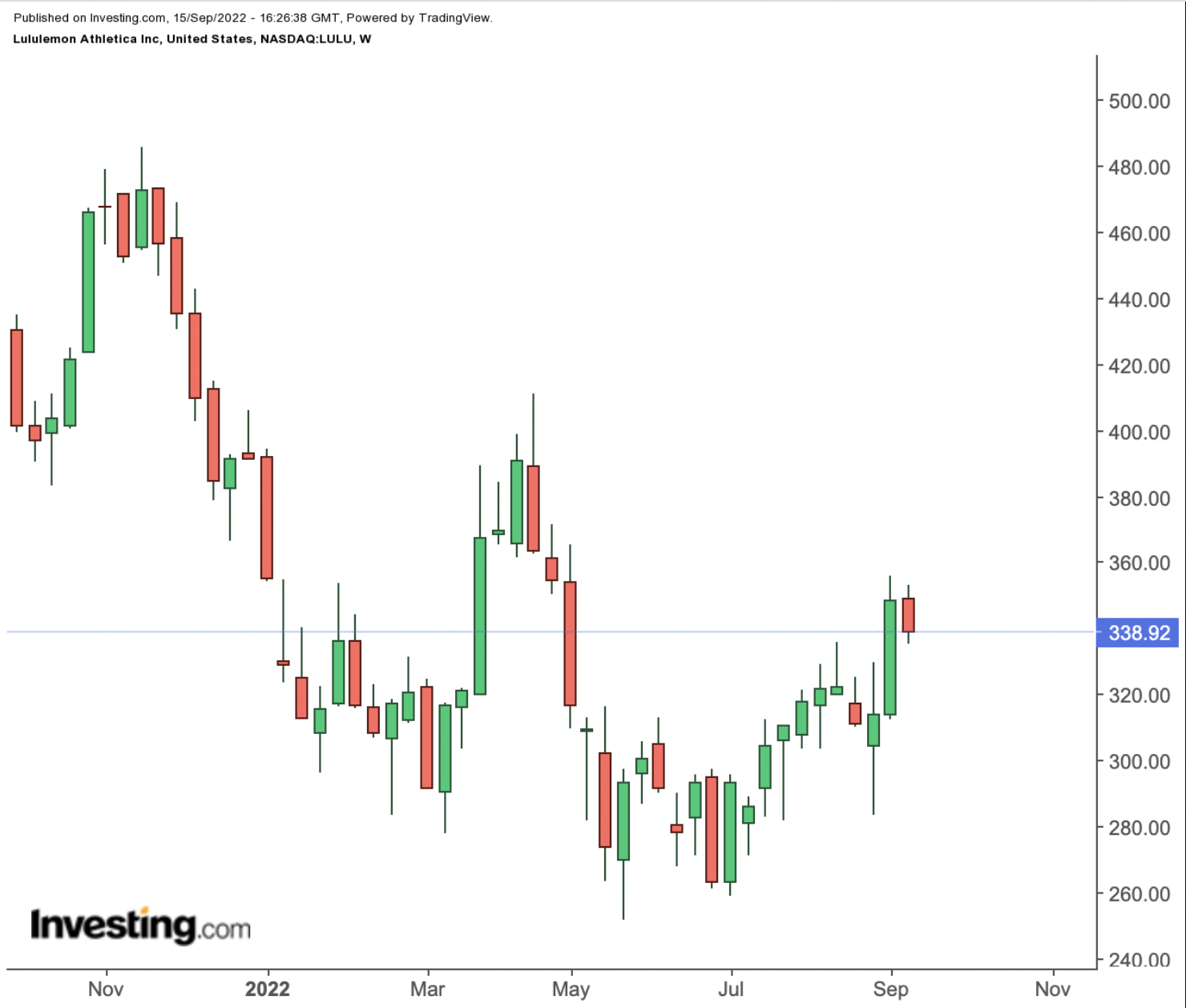- Lululemon’s second-quarter earnings were astounding in the current retail context
- Q2 should comfort investors worried about how the company will fare amid inflationary and recessionary risks
- Valuation is high, but like its products, LULU is worth it
It’s worth putting into context just how impressive second-quarter earnings from Lululemon Athletica (NASDAQ:LULU) truly were.
Yes, the company crushed analyst estimates in the quarter, and gave a full-year outlook above Wall Street consensus. But that’s not the most important aspect of the release.
What’s impressive is the performance relative not to expectations, but to the rest of the apparel industry, and indeed retail as a whole. Lululemon is thriving while essentially everyone else is struggling.
Thanks in part to a post-earnings rally, LULU admittedly isn’t cheap. But the stock hasn’t been cheap for years, yet it’s been one of the better performers of the past decade. As far as large-cap names, there’s a case that the same will be true over the next 10 years as well.

Source: Investing.com
Apparel Retailers Struggle
In 2021, consumers were buying things, apparel included. Even struggling mall retailers posted strong revenue growth. Importantly, they did so without the discounting and promotions that had marked the pre-pandemic environment. As a result, operating margins soared.
In contrast, 2022 has been a completely different story. With normalcy returning, spend on travel and experiences has returned. Labor Day air traffic in the U.S. exceeded pre-pandemic levels. With so much new stuff clogging closets, there simply is far less need for new apparel.
As a result, same-store sales have plunged across the industry. Even the biggest and best retailers like Walmart (NYSE:WMT) and Target (NYSE:TGT) dealt with billions of dollars in excess inventory. Smaller specialty retailers have seen their profits — and, in most cases, their stock prices — return to 2010s levels.
Add inflationary pressures, and the environment for retail is as difficult as it’s been since the financial crisis — at least.
Lululemon Thrives Anyway
But none of those headwinds were apparent at all in Lululemon’s second quarter. Comparable-store revenue increased a sizzling 23%, even with a two-percentage-point hit from the stronger U.S. dollar. Adjusted operating margins increased slightly.
In the release, Lululemon offered comparisons to the second quarter of fiscal 2019. Over that three-year period, revenue more than doubled. Gross margin expanded and adjusted earnings per share rose a sizzling 135%. Inventories did rise sharply, but management insisted that the inventory was appropriate for the sales expected in the second half of the year.
In any environment, that type of growth would be impressive. In this environment, it’s astounding.
Is Performance Priced In?
In terms of the business, it’s difficult to find a concern. This is a quality business that clearly has struck a chord with consumers worldwide. (About one-third of sales so far this year have come from outside the U.S.) Operating margins over 20% are among the highest in the industry, showing that consumers are willing to pay up for Lululemon quality.
Competition is far in the distance. Gap Inc. (NYSE:GPS) has its Athleta nameplate, but its sales and margins are far below those of Lululemon.
The only real question is the stock price.
Given guidance, which usually is conservative, Lululemon should generate about $10 in adjusted earnings per share. That implies a 34x price-to-earnings multiple.
In the context of current growth, that multiple doesn’t seem that expensive. For the full year, EPS should grow in the range of 28% year-over-year.
But apparel customers can be fickle. It only takes one fashion misstep to ding sales and pressure margins. A gradual return to the office could boost business professional and business casual options at the expense of Lululemon’s “athleisure” offering. Even Wall Street doesn’t seem that excited: the average price target of $381 only suggests about 11% upside over the next 12 months, and analysts usually are overly optimistic.
Certainly, a market-driven sell-off would create a more attractive price and a more attractive bull case. But even here, it’s difficult to argue too forcefully against the stock. The long-term performance and the dominance versus competitors both suggest Lululemon has years of growth ahead. Strong performance in men’s apparel expands the company’s market.
The clear comparison at this point is Nike (NYSE:NKE), another stock that historically has looked too expensive. Even with a sharp pullback, NKE has been one of the best stocks of the century, gaining more than 1,600%.
Lululemon has similar potential: to both dominate and expand its category, maintaining impressive profit margins all the while. Lululemon currently has a market capitalization of $43 billion; Nike’s is almost four times as high.
And so as long as Lululemon continues to execute like this, LULU stock can keep rallying.
Disclaimer: As of writing, Vince Martin has no positions in any securities mentioned.
